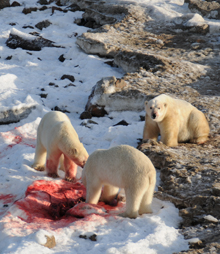Late Sea Ice Formation May Affect Polar Bear Survival: In Good Condition For Now
 Hundreds of polar bears in northeastern Manitoba may face an increased risk of starvation due to delayed ice formation along the western coast of Hudson Bay, conservationists say.
Hundreds of polar bears in northeastern Manitoba may face an increased risk of starvation due to delayed ice formation along the western coast of Hudson Bay, conservationists say.
Higher-than-normal temperatures have prevented ice from forming in the region, putting it three to four weeks behind schedule, according to the Canadian Ice Service, a division of Environment Canada.
As a result, minimum ice cover there is the lowest since 1971, CIS forecaster Luc Desjardins said.
The formation of sea ice is critical for polar bears, which use it as a platform for catching seals and other marine mammals.
 While a recent aerial survey of 333 polar bears along the bay’s western coast showed the bears to be in good condition, conservationists worry the animals’ good health will deteriorate quickly if ice does not form in the next few weeks.
While a recent aerial survey of 333 polar bears along the bay’s western coast showed the bears to be in good condition, conservationists worry the animals’ good health will deteriorate quickly if ice does not form in the next few weeks.
Delayed ice coverage
“The conditions that are currently occurring are indicative of the ice coverage that we would see probably in the mid-October time frame, rather than the mid-November,” Desjardins told CBC News.
Normally by this point, a thin layer of ice up to 28 kilometres long would have formed, stretching seaward from the bay’s western and southern coastlines, he said.
“The ice is almost non-existent this year, compared to our long-term normal,” Desjardins said.
Where there is ice, “it’s very patchy in terms of formation and it’s not a distinct pattern that affects the entire length of the coast of Hudson Bay.”
Desjardins stressed that the amount of ice has fluctuated in recent years and 2010 levels are not “significantly different” from those of the last five or six years.
What is different, however, is temperature: the region’s air temperature is “consistently warmer” than in recent years, he said.
In Nunavut’s Foxe Basin, the temperature is 14 degrees above normal. Overall, the bay region’s temperature is about four degrees above normal.
Fat reserves dwindling
Winter is the polar bear’s feasting season. From November until early summer, they fatten themselves as much as possible on ringed seals, bearded seals and other mammals. In the summer, during what’s called a “walking hibernation,” the average polar bear loses 1.6 kilograms of weight per day.
Three polar bears feast on a seal carcass along the western shore of Hudson Bay in Manitoba. Conservationist Darryll Hedman believes the seal likely washed ashore during high tide and was stranded. (Darryll Hedman/Manitoba Conservation) Ideally, the slow, heavy predators find themselves with enough weight at the end of the summer to make it back onto the ice platforms and hunt anew for fatty mammals.
“The longer that ice is in forming, the longer the polar bears have to survive on the fat reserves they put down in the spring and conserved right through the summer,” said Peter Ewin, an Arctic specialist for the World Wildlife Fund.
“The later it gets, the more weak bears there are who probably aren’t going to make it through,” he said.
On Nov. 17, Manitoba Conservation, along with the WWF, Polar Bears International, and York Factory First Nation Resource Management Board, conducted an aerial survey of 333 polar bears along Hudson Bay’s western coast. The bears had been off the ice since July 15.
The results were “surprisingly pleasant,” said Darryll Hedman, a regional wildlife manager for the provincial agency.
Many of the mostly single, adult males were relatively fat, with “wide rear ends” and a belly “with a dish to it,” Hedman said. Cubs were also considered to be doing well, based on how their fat rippled when they ran.
“As far as I’m concerned, the condition of the bears that we’ve seen in the last couple of days, they’re doing OK,” he said. “The condition of them was good.”
‘A snapshot in time’
Hedman emphasized the aerial survey was “just a snapshot in time” and warned the bears will become “exponentially skinnier.”
“As time goes on, and the ice doesn’t come in, they’re going to be getting hungrier and hungrier,” he said.
Desjardins, Hedman and Ewin all agree the ice will come, and form as it should. But none of the men can say, of course, exactly when.
“Hudson Bay will freeze over this winter, there’s no doubt in my mind,” said ice expert Desjardins.
“All we can do for now is monitor the conditions and, hopefully, that ice starts to show up in the next two to three weeks,” Hedman said. “The bears, they’ve got a ways to go yet.”



